

@RNGherb @Nat_SCA. Mitigating the potential contamination risk incurred in sampling herbarium specimens for phytolith reference collection. Preparing Cacti Herbarium Sheets. The ReCAP: Stories from California Herbaria. When you first learn about stacks of plant specimens housed in herbaria, it is tempting to envision these collections as quiet, inanimate storage spaces.
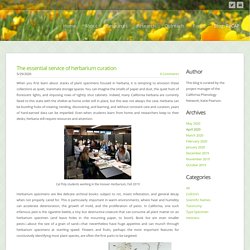
You can imagine the smells of paper and dust, the quiet hum of florescent lights, and imposing rows of tightly shut cabinets. Indeed, many California herbaria are currently fated to this state with the shelter-at-home order still in place, but this was not always the case. Herbaria can be bustling hubs of creating, tending, discovering, and learning, and without constant care and curation, years of hard-earned data can be imperiled. Even when students learn from home and researchers keep to their desks, herbaria still require resources and attention.
PNADU844. Designing a state-of-the-art taxonomic research workstation - The Plant Press. From Plant Press, Vol. 22, No. 3, July 2019.

As botanists develop more knowledge the science of taxonomy becomes increasingly complex. Between 1753 and 2016, the number of known plant species has risen from about 6,000 to 390,000, an average increase of nearly 1,500 species each year. Over 2,000 new species were discovered in 2015. The number of specimens held globally in herbaria has also increased.
There are now over 3,000 herbaria around the world holding nearly 400 million specimens. Applications in Plant Sciences. The instructions below use a sample iNaturalist data set (see Appendix S1) and an associated blank template for generating herbarium labels (Appendix S2) similar to that shown in Fig. 1B.
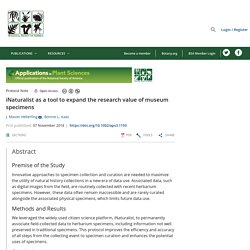
This section of the protocol was written using Microsoft Word 2016 and Windows 7 Professional. Appendix S2 and the associated protocol steps below can be adapted for other word processors (e.g., LibreOffice) and operating systems. 1 Downloading a QR code generator for your word processing software— Before you can make QR codes on labels you must have QR4Office add‐in installed in your Microsoft account.
Make sure you are logged into your Microsoft account. Look what we found @WSYherbarium, it's a "Herbarium drawing and dimensions" sketched onto the rear flyleaf of Arthur Broughton's Enchiridion Botanicum, 1782 [581.9 (4A) Bro]. #FridayFinds #FlyleafFriday… This looks like a beautiful way of displaying your #herbarium sheets! I wonder if the upright position was harmful in the long run though? Stunning solution otherwise. From an #advert in a 1933 Museums Journal. #throwbackthursday #tbt #museums #nathist…
INHS Herbarium at Illinois sur Twitter : "#ICYMI: Please stop by anytime between 9am–5pm this Friday (1/4) to help us fold paper packets for our #fungal and #bryophyte collections! We'll be at the Forbes Natural History Building, 1816 S. Oak St., Champaig. Mollusca Types in Great Britain. The location and status of older type material are not always clear, and indeed the types of many taxa remain to be tracked down.
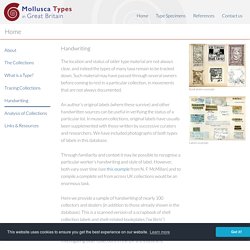
Such material may have passed through several owners before coming to rest in a particular collection, in movements that are not always documented. An author’s original labels (where these survive) and other handwritten sources can be useful in verifying the status of a particular lot. In museum collections, original labels have usually been supplemented with those written by successive curators and researchers. Paperclip crimes against specimens. Sad. #CurationCrimes…
Herbarium Specimen Label Tutorial. Size Doesn’t Matter: Fundamental Requirements in Relocating a Herbarium. Containing the Spirits: Lessons learned from the Management of Australasian Herbarium Wet Collections. Meta-paper. Imaging. The digitization project in the herbarium continues!
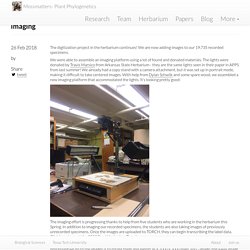
We are now adding images to our 19,735 recorded specimens. Fern volunteer at RBGE. Bringing Joseph Banks into the 21st Century. Sir Joseph Banks, Born 24 February 1743 was a collector of natural history specimens.
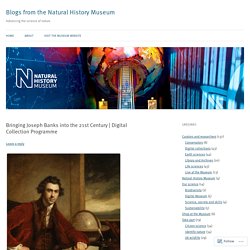
He was an avid botanist and his collection included a significant collection of insects. His collection was originally left to Banks’ librarian Robert Brown, but to the British Museum thereafter. Banks was an influential man who was president of the Royal Society 1778 to his death in 1820. This enabled him to continue supporting expeditions and forging networks bringing together specimens from the Atlantic, Indian and Pacific worlds. Banks entomology collection. Plants in Flatland; or the ups and downs of turning organisms into paper. » Unearthing History in the Herbarium.
Amy Weiss works in The New York Botanical Garden’s Herbarium, cataloging and preserving plant specimens from around the world.
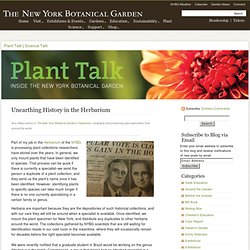
Part of my job in the Herbarium of the NYBG is processing plant collections researchers have stored over the years. In general, we only mount plants that have been identified to species. That process can be quick if there is currently a specialist–we send the person a duplicate of a plant collection, and they send us the plant’s name once it has been identified. However, identifying plants to specific species can take much longer if there is no one currently specializing in a certain family or genus. Cleaning a specimen – by Jamie Matley « Herbology Manchester. Cleaning a specimen – by Jamie Matley.
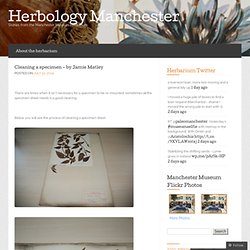
Tape: A Field Book Tale of Terror - Field Book Project. By Andrea Hall, Field Book Project Conservator *Cue the peals of thunder and blood curdling scream!
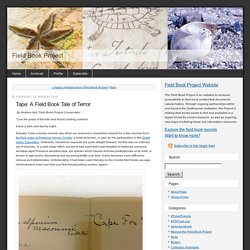
It was a dark and stormy night… Actually, it was a lovely summer day when we received a researcher request for a few volumes from the field notes of Frederick Vernon Coville, a botanist known, in part, for his participation in the Death Valley Expedition. Ordinarily, researcher requests are quite straight forward, but this was no ordinary set of volumes. In a past repair effort, someone had used that most dreaded of materials, pressure sensitive tape! Standards in the Care of Botanical Materials. Society of Herbarium Curators. Vasculum13.2. Herbarium Management. I.

A Plant Morgue An herbarium is a collection of pressed, dried, and labeled plants (and may also include other types of collections including wood or seeds). Perhaps a less morbid analogy is that an herbarium is a reference library of plants. It is generally agreed that Luca Ghini (1490-1556), Professor of Botany at the University of Bologna, prepared the first herbarium specimens as we recognize them today. His students, Cibo, Turner, Aldrovandi and Cesalpino also made herbaria, some of which still exist (John McNeill, 1997; Taxacom Discussion). Another contender for the oldest herbarium specimen is an olive branch removed from King Tut’s tomb (Craig Hilton-Taylor, 1997; Taxacom discussion). II. Monetary Value.
III. Making herbarium specimens at Kew. Kew’s herbarium houses approximately 7.5 million specimens of plants, which are used by Kew scientists and visitors to the herbarium on a daily basis – and are occasionally sent to other institutions for study. There are specimens in the collection that are 250 years old, and include material collected by the likes of Charles Darwin and some of Kew’s previous directors including W.J. Hooker and J.D. Hooker. In this blog post we explain how we mount (display on paper) specimens to ensure their availability for future scientists. RHS-Guide-to-making-herbarium-specimens. Collecting and Preparing Allium Specimens. Methodology for Collecting and Preparing Herbarium Specimen of Allium Pandey Anjula*, Pradheep K, Gupta Rita ICAR-National Bureau of Plant Genetic Resources, New Delhi, 110 012, India *Author for Correspondence: Email-anjula.pandey@icar.gov.in Online published on 18 June, 2016.
Thermo-lignum-warmair-treatment-method - Thermo Lignum. Using only naturally occurring elements, air and water, sound biological principles and established laws of physics, all insects inhabiting organic materials will die at any life-cycle stage when exposed to our Thermo Lignum® WARMAIR treatment method. The absence of any chemicals or noxious gases during the process allows immediate reuse of the items upon completion of the treatment, without risk of harm to your health, the object, or the environment. The Thermo Lignum® process essentially targets the susceptibility of insects to elevated temperatures of around 48-55°C dependent on the species.
From a conservation point of view the key to using warm air to kill insects is to maintain the moisture content of the material at a constant level during the heating, holding and cooling phases. DIY Plant Pressing. Field Museum specimen of Hill’s thistle (Cirsium hillii) found in Elgin, Illinois, in 1918.
How does a plant specimen get turned into an herbarium sheet, ready for a Museum collection? In order for plants to be carefully cataloged and preserved so that they can be studied well into the future, they first have to be dried and pressed. The herbarium sheet. Sea Flora Art: Easy Algae Herbarium Specimens! You will need the following things to make an algae herbarium specimen, the cost should be under $15 if you have none of these things already: : Watercolor Paper Or similarly water-absorbent and heavyweight paper. 140# or 300g+ weight is good, and make sure you get the right size for your frame if you have one.
Also make sure you can detach the paper from the book it comes from easily. Specimen Preparation Guide. Specimen Preparation Guide (Fragment Packets) Making an Herbarium Sheet Packet. Conservation and housing of a book of Sub-Himalayan fern specimens. Eleonora Lazzari has recently completed a two month conservation internship at the Special Collections Centre. Collection management and study of microscope slides: Storage, profiling, deterioration, restoration procedures. Abu-Gharbieh, W.I. & Smart, G.C. (1969) A polyethylene bottle applicator for sealing microscope coverglasses with a slide ringing compound. FREEZE-DRYING OF FUNGI DOES NOT WORK TOO WELL.
No. 117 November 2, 1995. Adam White's eastern Canadian Arctic material- conservation. Collections Care – Condition Survey. How NOT to number objects. Battle of the booklice. Conserving Harper’s Three-for-One Field Book. Plant Pressing - Botanical Art & Artists. How to press plants and make herbarium collections. Make a herbarium specimen. Repaired specimen. Really interesting concept of having the cabinets themselves as the #museum displays @beatymuseum - beautiful space!…